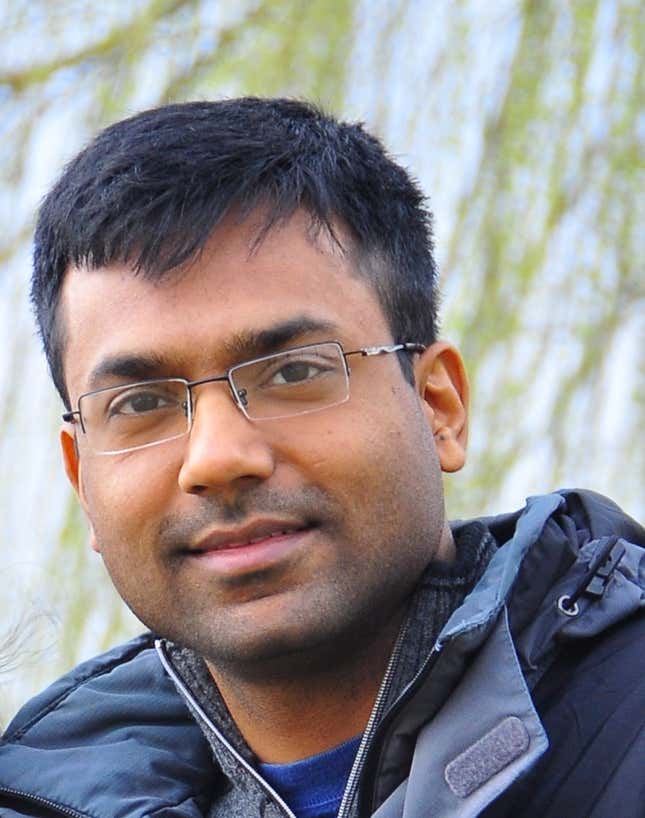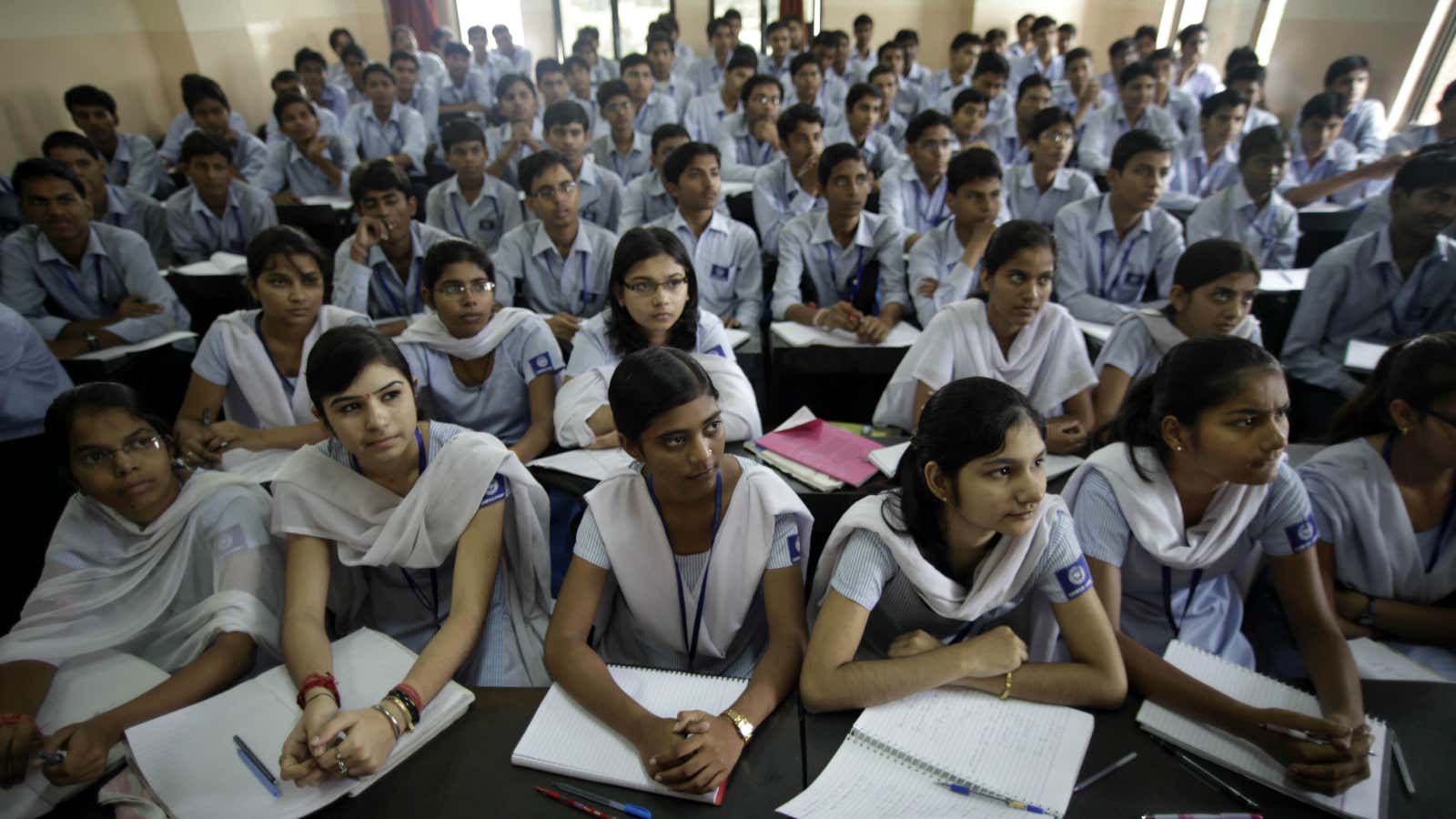Every year, millions of Indian students give up on sleep, sport and much more to prepare for one of the toughest tests on the planet—the Indian Institute of Technology (IIT) Joint Entrance Examination.
Ultimately, only 0.7% of these candidates make the cut and get a chance to study at the country’s most prestigious engineering colleges. And the ones who come first in this exam are briefly elevated to the status of a celebrity.
Within minutes of exam results being announced, TV channels start tracking down these toppers for interviews, glowing articles are written about them in newspapers, and occasionally their smiling faces stare down from billboard advertisement for leading cram schools.
But this glory does not last forever—and the world outside the IITs rarely tracks the trajectory of these academic overachievers.
Quartz, however, looked for them and found that majority of IIT toppers in the last decade have chosen academics or research over corporate drudgery. This is despite the fact that IITs are known for producing some of India’s most successful CEOs, investment bankers and entrepreneurs.
Here are profiles of toppers from from 2000 to 2010.
Not a single person in this list is a woman, which might have something to do with the gender ratio of IIT applications. In 2014, for instance, only 360,000 out of the 1.4 million students were women.
2000 – Nitin Gupta

A lack of skilled teachers in his hometown Bharatpur, in Rajasthan, compelled Gupta to leave his family at 14 and move to Kota, then an upcoming hub for IIT-JEE cram schools in India.
“In those days, the exam included tough subjective questions, so both the teachers and the students knew that rote memorisation would not serve any purpose,” Gupta told Quartz.
Two years of rigorous coaching later, in 2000, he emerged as the all-India topper. He joined IIT-Kanpur, and after a bachelors degree in computer science, he changed tracks to explore biology. Eventually, Gupta completed a PhD in bioinformatics and systems biology at the University of California, San Diego.
Then, he chose to go back to the same engineering school he graduated from. Gupta is currently an assistant professor at IIT-Kanpur’s biological and bioengineering department.
“I like the freedom that academics provides: In terms of what problems you want to work on, as well as in terms of your work schedule,” the 32-year old explained. ”So, unless you want to earn crazy amounts of money, academics is a great profession for those interested in science.”
And unlike many of his peers, Gupta decided to work and live in India.
“Perhaps, as a child, I read too many articles on brain drain,” he told Quartz. ”I went to the US with the clear idea that I will come back after studying, and never reconsidered it (staying back).”
2001 – Arvind Thiagarajan
IIT-Madras wasn’t just the finest engineering college in Thiagarajan’s city; it was also a bit of a family tradition.
After attending one of Chennai’s most sought-after coaching institutes, Thiagarajan followed his father’s academic trajectory and landed a place at IIT-Madras in 2001.
“I wouldn’t say I come from a family of scientists, but I was always interested in math, which later fit naturally into a career in computer science,” he told Quartz. That obsession resulted in an application to the Massachusetts Institute of Technology (MIT), where Thiagarajan completed a PhD in computer science.
Still, academia wasn’t enough and Thiagarajan instead settled for a career in the technology industry. “I realised during my PhD that, especially in computer science, you can have as much or more impact and freedom in industry working on products or starting your own thing, than publishing papers in academia and pure research,” he explained.
Thiagarajan now works as a research scientist at Amazon.
2002 – Dungara Ram Choudhary
How does a boy from Jalore, a nondescript city in the middle of the Rajasthan desert, land up in Silicon Valley? Well, it helps if you ace the IIT-JEE.
That’s precisely what Dungara Ram Choudhary pulled off in 2002, before deciding to attend IIT-Kanpur. There, according to his LinkedIn profile, he helped develop an online fingerprint verification system.
After a stint at California-headquartered Wi-Fi solutions firm, AirTight Networks, Choudhary—who is apparently also a Tae-Kwon-Do enthusiast—now works at Oracle.
2003 – Shashank Dwivedi
Very little seems to be publicly available about Shashank Shekhar Dwivedi, except that he lived in Bhilai, picked up a bronze medal in an International Physics Olympiad—and finished first in the IIT-JEE. (Aspire, a cram school in Bhilai, claims that Dwivedi attended their classes.)
Then, he went to study electrical engineering at IIT-Bombay, before attending MIT.
2004 – Sushant Sachdeva
For the Sachdeva brothers, acing the IIT-JEE is a family ritual.
Sushant studied computer science and engineering at IIT-Bombay as an Aditya Birla Scholar, and won the president of India‘s gold medal for graduating with the highest grade points.
Three years later, in 2007, his brother Prashant cracked the IIT-JEE exam. His rank: 75. His choice of college: IIT-Bombay.
Sushant, meanwhile, moved to Princeton University to begin a master’s degree in computer science and then chose to stay on at the Ivy League school for a PhD.
He currently works as a post-doctoral associate and instructor at Yale University’s computer science department, where he focuses on algorithms.
2005 – Piyush Srivastava
Even among those who champion the IIT-JEE, Srivastava’s test scores stands out.
At 17, Srivastava was ranked number one in the JEE exam, the all-India engineering entrance exam (AIEEE) and the Indian school certificate exam. He also won a gold medal at the International Physics Olympiad and stood second in the Uttar Pradesh state engineering entrance exam.
Schooled in Allahabad, Piyush eventually studied computer science at IIT-Kanpur, where he won the president’s gold medal at the college and later turned to research. He is currently a postdoctoral scholar at the California Institute of Technology.
2006 – Raghu Mahajan

Mahajan was definitely not dazzled by the IITs.
He spent just two years at IIT-Delhi before moving to MIT to study physics.
“I was doing computer science at IIT-Delhi because of social pressures,” Mahajan told Quartz. “I transferred to MIT mainly because I wanted to study physics. The physics department at IIT-Delhi is not that strong in theoretical physics, which is what I wanted to pursue.”
In 2014, the Quacquarelli Symonds world university rankings ranked IIT-Delhi at 235, while MIT had topped the list.
“I had some friends who had gone to MIT right after class 12, and they told me how intellectually inspiring the place was,” he explained. “In contrast, much to my disappointment, I found the academic environment at IIT-Delhi to be quite depressing because two years of rigorous preparation for the JEE in classes 11 and 12 disillusions a lot of students.”
Mahajan is now at Stanford University pursuing a PhD in theoretical physics, focussing on string theory and the black hole information puzzle.
2007 – Achin Bansal
Bansal is the first student from the Punjab school education board to top the IIT-JEE. The son of a paediatrician, he went to a school built in the memory of his grandfather in Kotkapura, a small Punjab town once known for its prolific cotton crop. He then attended coaching classes in Kota.
With a scholarship from the Punjab government, Bansal read for a degree in computer science at IIT-Bombay and currently works as an associate at Morgan Stanley, Mumbai. His job, according to his LinkedIn profile, includes looking at the valuation of financial derivatives.
2008 – Shitikanth Kashyap
When the results of JEE were announced in 2008, Kashyap fled his hometown Patna and went to Mumbai. The reticent topper just couldn’t deal with all the attention he was getting from the media and politicians.
“My house is no longer the normal place I lived in all these years,” Kashyap complained less than a week after the IIT-JEE results were announced. Several cram schools wanted to make him their brand ambassador and bugged him relentlessly, even as politicians apparently fell over each other to “felicitate” him.
Kashyap studied computer science at IIT-Kanpur. In July 2008, he also won the gold medal at the 39th International Physics Olympiad, but he was already famous after his IIT-JEE exploits. Kashyap is now at Canada’s University of Waterloo, where he is completing a PhD in quantum computing.
2009 – Nitin Jain
Like Shrivastava in 2005, Jain had also topped AIEEE along with IIT-JEE and then went to study at IIT-Delhi.
While in college, Jain received a death threat via email reportedly after he published a book called The Secret of my Success. The book had alleged that a few coaching institutes in India had misused his name for commercial interests.
Jain had then said that FIIT JEE, an institute he trained at, had forced him to write a letter praising the institute, while another Delhi-based cram school, Aakash Institute, had claimed credit for his success. Following the allegations, the government had asked the Central Bureau of Investigation to step in.
Jain, also a gold medalist at the international olympiad on astronomy and astrophysics in 2010, currently lives in Dublin, Ireland.
2010
–
Anumula Jithendar Reddy
Reddy had no plans to study engineering until he completed his class 10. It was only after his parents shifted him to Hyderabad from Warangal, a town in Andhra Pradesh, that he started to focus on preparing for the JEE exam.
The son of a professor at the National Institute of Technology, went on to study electrical engineering at IIT-Bombay.
While very little is publicly available about what Reddy is doing now, he had—immediately after he topped the JEE—said that he wanted to go to Stanford University to take up research in physics and turn to academics after his graduation.
We welcome your comments at ideas.india@qz.com.
